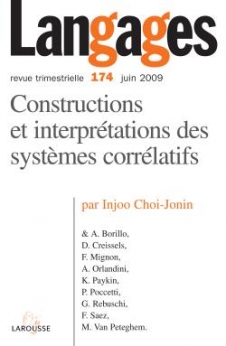
Langages n° 174 (2/2009)
Pour acheter ce numéro, contactez-nous
Recevez les numéros de l'année en cours et accédez à l'intégralité des articles en ligne.
Deux types de faits seront abordés : (i) le marquage casuel du régime pronominal du subordonnant comparatif en roumain et en italien (cf. section 2) et (ii) la concurrence entre le subordonnant QU- et une préposition, surtout en italien, mais également dans d’autres langues (cf. section 3). Il s’agira surtout d’examiner si ces faits vont à l’encontre de l’hypothèse selon laquelle la structure comparative constitue un type de corrélative. Il ressortira de l’analyse que dans certaines langues le « complément comparatif » n’est pas toujours de nature propositionnelle, mais peut être prépositionnel, notamment lorsque le comparant est un pronom ou un SN. Autrement dit, la structure comparative n’est donc pas nécessairement corrélative si on entend par ‘corrélation’« une relation de dépendance mutuelle entre deux propositions ».
Subordinate comparative clauses mostly do not contain a verb and are then considered to be elliptic CPs. Nevertheless there are languages in which the comparative clause cannot always be analysed as an elliptic clause. This paper focuses on two cases in which an elliptic analysis is impossible. In the first case, occurring in Italian and Romanian, the comparative clause contains a pronoun in the accusative case instead of the expected nominative case and the pronoun appears to receive its case from the complementizer, which thus acts as a preposition. In the second case, the comparative complement is marked by a preposition (cf. Italian or, with cardinals, in all Romance languages) or by a case (e.g. ablative in Latin, genitive in Russian and in Modern Greek). In the two cases the comparative complement cannot be analysed as a clausal constituent. The non clausal structure exhibits a kind of short cut : although a comparison always concerns two degrees of one or two different predicates, it is made directly between two alternative arguments of the predicate. This short cut appears mostly when the compared arguments are the subject of the predicate.

